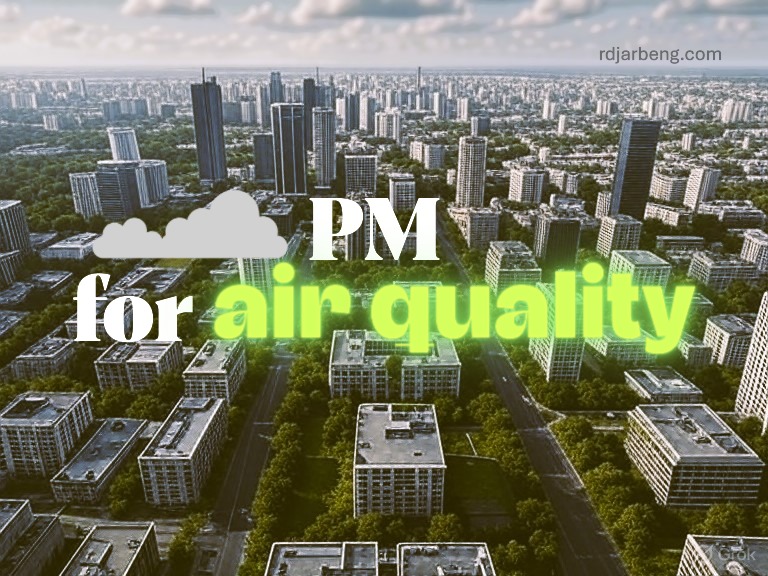What is Particulate Matter (PM2.5) and the Environmental Significance
Particulate Matter (PM) comprises a diverse mix of solid and liquid particles suspended in the atmosphere, varying in size, chemical composition, and origin (U.S. Environmental Protection Agency [EPA], 2023). Among these, PM2.5—particles with an aerodynamic diameter of 2.5 micrometers or less—is a critical air pollutant due to its ability to penetrate deep into the respiratory system and bloodstream, posing significant health and environmental risks (World Health Organization [WHO], 2021). This article examines the composition of PM, the primary and secondary sources of PM2.5, and their broader implications, drawing on peer-reviewed literature and authoritative sources to provide a comprehensive overview.

Composition of Particulate Matter
PM consists of various chemical and physical components, each contributing to its environmental and health impacts. The primary constituents include:
- Sulphates: Formed through the oxidation of sulfur dioxide (SO₂), primarily emitted from industrial processes and power plants (Seinfeld & Pandis, 2016).
- Nitrates: Produced from reactions involving nitrogen oxides (NOₓ), commonly released by vehicle exhausts and industrial activities (Jacob, 1999).
- Ammonia: Originating from agricultural sources, such as fertilizer use and livestock waste, ammonia contributes to the formation of ammonium salts (Behera et al., 2013).
- Sodium Chloride (NaCl): Derived from sea spray in coastal regions (Lewis & Schwartz, 2004).
- Black Carbon (BC): A product of incomplete combustion of fossil fuels or biomass, known for its role in air pollution and climate warming (Bond et al., 2013).
- Mineral Dust: Fine particles from soil erosion, construction, or windblown sources (Prospero, 1999).
- Water: Liquid droplets that bind with other particles, influencing PM’s atmospheric behavior and transport (Seinfeld & Pandis, 2016).
These components vary by region and season, driven by local emission sources and meteorological conditions (European Environment Agency [EEA], 2023).
Sources of PM2.5
PM2.5 arises from both primary and secondary sources, each contributing to its atmospheric concentration and impacts.
Primary Sources
Primary PM2.5 consists of particles emitted directly into the atmosphere. Key sources include:
- Combustion Processes: Fossil fuel combustion in vehicles, power plants, and industries emits black carbon and organic aerosols (Bond et al., 2013).
- Biomass Burning: Wildfires and agricultural burning release significant PM2.5, particularly in rural areas (Reid et al., 2005).
- Industrial Activities: Construction, mining, and manufacturing generate mineral dust and other fine particles (EPA, 2023).
- Natural Sources: Volcanic eruptions and windblown dust contribute to primary PM2.5, though their impact is often localized (Prospero, 1999).
Secondary Sources
Secondary PM2.5 forms in the atmosphere through chemical reactions involving precursor gases:
- Sulfur Dioxide (SO₂): Emitted from coal-fired power plants and industrial processes, SO₂ oxidizes to form sulphate aerosols (Seinfeld & Pandis, 2016).
- Nitrogen Oxides (NOₓ): Released from vehicular and industrial emissions, NOₓ reacts to produce nitrate particles (Jacob, 1999).
- Ammonia (NH₃): Agricultural emissions of NH₃ combine with SO₂ and NOₓ to form ammonium sulphates and nitrates (Behera et al., 2013).
- Volatile Organic Compounds (VOCs): Emitted from solvents, paints, and vegetation, VOCs contribute to secondary organic aerosols through photochemical reactions (Hallquist et al., 2009).
These reactions are often catalyzed by sunlight or humidity, leading to elevated PM2.5 levels in urban and industrialized areas (EEA, 2023).
Health and Environmental Impacts of PM2.5
PM2.5 poses significant risks to human health due to its ability to penetrate deep into the lungs and bloodstream. Epidemiological studies associate PM2.5 exposure with respiratory conditions (e.g., asthma, bronchitis), cardiovascular diseases, and premature mortality (Pope et al., 2002; WHO, 2021). The WHO estimates that ambient air pollution, including PM2.5, contributes to approximately 4.2 million premature deaths annually (WHO, 2021).
Environmentally, PM2.5 affects climate by altering radiative forcing and cloud formation. Black carbon absorbs solar radiation, contributing to warming, while sulphates and nitrates scatter light, exerting a cooling effect (Bond et al., 2013; Intergovernmental Panel on Climate Change [IPCC], 2021). Additionally, PM2.5 reduces visibility, causing haze in urban environments (EPA, 2023).
Conclusion
PM2.5 is a complex pollutant with far-reaching health and environmental implications. Its diverse composition and sources—ranging from direct emissions to atmospheric chemical reactions—require targeted mitigation strategies. Reducing primary emissions through cleaner energy and industrial practices, alongside controlling precursor gases like SO₂ and NOₓ, is essential for improving air quality and public health. Continued research and policy efforts, as supported by organizations like the WHO and EPA, are critical to addressing this global challenge.
References
- Behera, S. N., Sharma, M., Aneja, V. P., & Balasubramanian, R. (2013). Ammonia in the atmosphere: A review on emission sources, atmospheric chemistry, and deposition on terrestrial bodies. Environmental Science and Pollution Research, 20(11), 8092–8131. https://doi.org/10.1007/s11356-013-2051-9
- Bond, T. C., Doherty, S. J., Fahey, D. W., et al. (2013). Bounding the role of black carbon in the climate system: A scientific assessment. Journal of Geophysical Research: Atmospheres, 118(11), 5380–5552. https://doi.org/10.1002/jgrd.50171
- European Environment Agency (EEA). (2023). Air pollution. https://www.eea.europa.eu/en/topics/in-depth/air-pollution
- Hallquist, M., Wenger, J. C., Baltensperger, U., et al. (2009). The formation, properties, and impact of secondary organic aerosol: Current and emerging issues. Atmospheric Chemistry and Physics, 9(14), 5155–5236. https://doi.org/10.5194/acp-9-5155-2009
- Intergovernmental Panel on Climate Change (IPCC). (2021). Climate change 2021: The physical science basis. https://www.ipcc.ch/report/ar6/wg1/
- Jacob, D. J. (1999). Introduction to atmospheric chemistry. Princeton University Press.
- Lewis, E. R., & Schwartz, S. E. (2004). Sea salt aerosol production: Mechanisms, methods, measurements, and models. American Geophysical Union. https://doi.org/10.1029/GM152
- Pope, C. A., Burnett, R. T., Thun, M. J., et al. (2002). Lung cancer, cardiopulmonary mortality, and long-term exposure to fine particulate air pollution. Journal of the American Medical Association, 287(9), 1132–1141. https://doi.org/10.1001/jama.287.9.1132
- Prospero, J. M. (1999). Long-range transport of mineral dust in the global atmosphere: Impact of African dust on the environment of the southeastern United States. Proceedings of the National Academy of Sciences, 96(7), 3396–3403. https://doi.org/10.1073/pnas.96.7.3396
- Reid, J. S., Koppmann, R., Eck, T. F., & Eleuterio, D. P. (2005). A review of biomass burning emissions part II: Intensive physical properties of biomass burning particles. Atmospheric Chemistry and Physics, 5(3), 799–825. https://doi.org/10.5194/acp-5-799-2005
- Seinfeld, J. H., & Pandis, S. N. (2016). Atmospheric chemistry and physics: From air pollution to climate change (3rd ed.). Wiley.
- U.S. Environmental Protection Agency (EPA). (2023). Particulate matter (PM) basics. https://www.epa.gov/pm-pollution/particulate-matter-pm-basics
- World Health Organization (WHO). (2021). Ambient (outdoor) air quality and health. https://www.who.int/news-room/fact-sheets/detail/ambient-(outdoor)-air-quality-and-health

